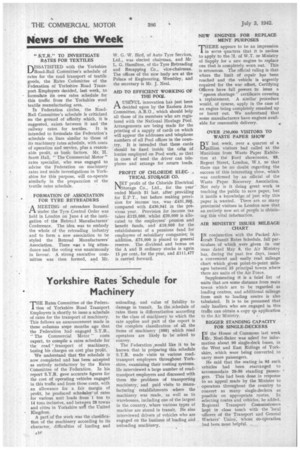Yorkshire Rates Schedule for Machinery
Page 18

If you've noticed an error in this article please click here to report it so we can fix it.
THE Rates Committee of the Federation of Yorkshire Road Transport Employers is shortly to issue a schedule of rates for the transport of machinery. This follows an announcement made in these columns sotpe months ago that the Federation had engaged S.T.R., " The Commercial Motor " costs expert, to compile a rates schedule for the road ',transport of machinery, basing his charges on cost plus profit.
We understand that the schedule is now completed and has been accepted as entirely satisfactory by the Rates Committee of the Federation. In his report S.T.R. gave accurate figures for the cost of operating vehicles engaged in this traffic and from those costs, with an allowance for a fair margin of profit, he produced schedulesof rates for various unit loads from 1 ton to 14 tons inclusive, and betnen 28 towns and cities in Yorkshire an the United Kingdom.
A part of the work was the clasSification of the machinery according to its character, difficulties of loading and unloading, and value of liability to damage in transit. In the schedule of rates there is differentiation according to the class of machinery, to which the rate applies and part of the report is the complete classification of all the items of machinery (500) which road operators are likely to be asked to convey.
The Federation would like it to be known that in preparing this schedule S.T.R. made visits to various road. transport employers throughout Yorkshire, examining their costing systems. He interviewed a large number of roadtraniport employers and discussed with them the problems of transporting machinery, and paid visits to manufacturing establishments where the machinery was made, as well as to warehouses, including one of the largest in the country, where various types of machine are stored in transit. He also interviewed drivers of vehicles who are engaged on the business of loading and unloading machinery.




















































